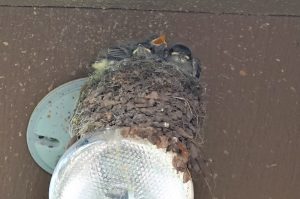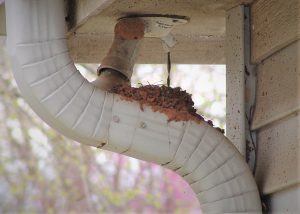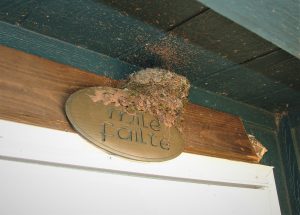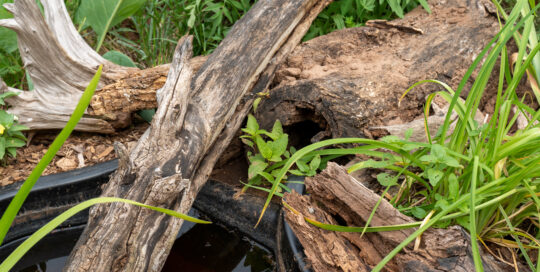Who is that nesting under my eaves?
Views: 7622

“So, what’s up with that board above your front door?” a friend asked.
I shrugged because I didn’t know. For some reason, one of the previous owners had nailed an unpainted board at a slight angle right above the front door. And then they’d stuffed newspapers in the side openings to…. I don’t know, add a touch of class to the entryway? “I think the newspapers are probably to prevent wasps from making nests behind it,” I said, even though that didn’t precisely answer her question. That was, at least, a reasonable guess about the purpose of the newspapers, given the number of red wasps buzzing around.
The board was scheduled to come off eventually, but it was low down the priority list. Having a functional house that isn’t full of unpacked boxes is more crucial than the weird board above the front door. Besides, we’d become accustomed to the weird board above the door, newspapers included. It’s amazing what you can learn to ignore when crushed by stress and a to-do-list that runs on forever.
In the process of unpacking, we unearthed a small plaque with a Celtic welcome message on it. Kate decided to hang it above the front door right away.
It wasn’t long before we discovered why we had that weird board above our door.
Bird Visitors
It turns out that ever since somebody nailed the weird board above our door, there was a pair of phoebes hanging out in our yard cursing human ingenuity for depriving them of their favorite nesting site. No doubt they watched with glee while Kate nailed up just what they needed to reclaim their treasured spot: a ledge above the door on which to start building their nest. Our timing couldn’t have been better for them.

Eastern Phoebe
There are many birds that will build nests on or in close proximity to houses. Eastern phoebes like to build under porches, on outside lights, gutter downspouts, or any sheltered area with a ledge or niche. Barn swallows will utilize similar spaces, sometimes even taking over old phoebe nests.

Sheltered spots with ledges are favorite spots to build.
Other birds that build on houses include cliff swallows, robins, house finches, pigeons, house sparrows, and European starlings. Chimney swifts will nest in unprotected chimneys, and Carolina wrens will nest virtually anywhere they find a suitably sheltered spot. (My mother had them nesting in a wreath on her front door. We’ve had them nest in hanging flower pots.)
Mockingbirds
Mockingbirds will build nests in shrubbery next to or near houses, and they aggressively defend their nest sites. I had neighbors once who couldn’t use their front door for weeks because they’d be dive-bombed by protective mockingbirds the minute they stepped outside.
While my neighbors were inconvenienced by their mockingbirds, they tolerated the situation with good humor. They enjoyed the birds in their yard, and they understood the inconvenience was temporary. Similarly, our nesting phoebes have made a muddy mess of our front door, but we love them in the yard eating our unwanted insects. At night, they take advantage of the moths attracted to our porchlight. (Yum! Moths for a midnight snack!) I love my birds, and I’ll put up with them nesting almost anywhere.
Discouraging birds safely
It’s understandable if you don’t like birds nesting on or around your house, but don’t try to discourage them once they begin building or move nests that are already built. Native birds are protected by law (the Migratory Bird Treaty Act), making it illegal to interfere with them or their nests. The time for prevention is prior to or after nesting season. Seal niches, cavities, and crevices that might attract them. Suspend fruit tree (bird safe) netting from eaves to protect ledges, rafters, downspouts, and similar areas. Birds are also repelled by noise and flashing lights, so hanging strips of mylar or shiny wind chimes may be enough to encourage them to go elsewhere.

And finally, you can protect ledges or other surfaces by adding a piece of metal or board to create a 45- to 60-degree slope. Nesting materials will slide off such a slope, making it impossible for the birds to build their nests. If you use this method, however, I don’t recommend you stuff newspapers underneath to seal the void. And definitely don’t add a plaque on top to defeat its purpose.
Meet Leslie Miller
Leslie Ann Miller shares 3.5 acres in rural Oklahoma with birds, butterflies and wide variety of animals. She is currently transforming her yard with plantings…
Leslie's Recent Posts

Creating microclimates and microhabitats to benefit wildlife






